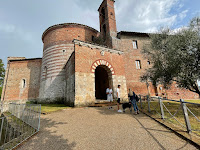OK, I admit it. I think about Romans several times a week.
It’s not that I have much choice. If you are living in Italy as an expatriate, you are here for the beauty and history. Much of that beauty came from the ancient Romans who, by definition, also supplied the history.
So yes, I think about Romans every time I pass a sign to an archeological site or look at an old stone wall. The Romans left an incredible legacy that is impossible to ignore if you are in Italy.But I can’t quite understand the current social media fascination with the Roman Empire. That’s the last half of the Roman civilization and was dominated by tyrants, declining freedoms and the eventual collapse of a culture that had thrived for half a millennium.
The real attention should be on the Roman Republic. This period from 510 BCE to 31 BCE is where most of the Roman inventions and culture that Hollywood so loves were invented. And though it wasn’t a perfect democracy, Romans during the Republic voted on everything from leaders to public works projects to wars.
They learned much of that from their predecessors here in Tuscany – the Etruscans. Unfortunately, the Etruscans were much better at making wine, mining silver and commerce than at crafting great buildings or fighting wars. Which left the historical record in favor of the folks who were much better at those latter two – the Romans.
To be clear, Roman Republicans were not all good guys. They fought constantly, enslaved anyone they conquered and split their society (and votes) between elitist patricians and not-so-common plebeians. But they did vote and they didn’t just put up with autocratic tyrants. Even with the inefficiencies of democracy, they were the ones who came up with most of the grandeur for which we gasp “This was Rome!.”
The current social media trend seems to focus on the pomp and gallantry of the Roman legions and the results of Roman engineering. But I think the vision of hunky guys in short-skirts and bronze helmets is as fuzzy as standing back and looking at the Coliseum and saying “cool building”.
I’m much more interested in the “how” of everyday Rome than the what. If you walk through the streets of Pompeii, you cannot help be but be impressed with the density and quality of the construction. It’s a full city – and still standing.
I look at Roman ruins and ask “how did they do it?” not in the sense of how did they invent all of those cool things, but in the actual question of how they physically did it.
Think about what is missing from those Hollywood toga-ripper movies. Someone had to engineer those great aqueducts (try calculating just the area of a rectangle in Roman numerals), dig up a whole lot of rock and gravel and then transport it to the building sites. You don’t put a ton of gravel in a chariot. There were no Ready-Mix plants and cement trucks to provide that huge mass of concrete the Romans used.
So the less-attractive vision of the Roman civilization is of thousands of dowdy oxcarts clogging the roads as the great Roman legions march off to yet another construction site. That’s right – Roman soldiers were the hardhats of the civilization in peace as well as war. When they were not hacking off barbarian heads or besieging Etruscan wine warehouses, they were the literal backbone of the Rome we now marvel. Roman soldiers were required to build roads, temples, palaces and their own barracks. When you spend most of your days tossing around blocks of tufa, you are in great shape for the occasional hand-to-hand battle.
So yes, I think of the Romans as I visit what they left behind centuries ago. And I am puzzled that we left their accomplishments behind to wallow in the Dark Ages after their fall. But I’m not obsessed by them.
I’m more obsessed by the lesson that a civilization that could rise so wonderfully could fall so thoroughly. I’m not ready to trade for Pax Americana through the destruction of the Republic.

















